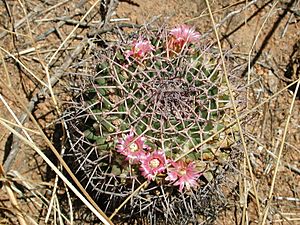Mammillaria carnea facts for kids
Quick facts for kids Mammillaria carnea |
|
|---|---|
 |
|
| Scientific classification | |
| Genus: |
Mammillaria
|
| Species: |
carnea
|
Mammillaria carnea is a unique type of cactus that belongs to the large Cactoideae family. It's known for its interesting shape and pretty flowers. This plant is a succulent, meaning it stores water in its thick stems to survive in dry places. It's a popular choice for cactus lovers because it's quite easy to care for and has a distinct look.
Contents
About the Mammillaria carnea Cactus
The Mammillaria carnea cactus was first officially described in 1837 by two botanists, Joseph Gerhard Zuccarini and Ludwig Karl Georg Pfeiffer. These scientists studied and named many plants during their time. This particular cactus is part of the Mammillaria genus, which is one of the largest groups of cacti.
Where Does This Cactus Live?
This fascinating cactus is native to Mexico, specifically in the central and southern parts of the country. It thrives in dry, rocky areas where other plants might struggle to grow. You can often find it on hillsides or in valleys, soaking up the sun. Its natural habitat is usually at higher elevations, where the climate can be quite harsh with long dry periods.
What Does the Mammillaria carnea Look Like?
The Mammillaria carnea cactus has a distinctive shape that makes it stand out. It usually grows as a single, rounded stem, but sometimes it can form small clusters. The stem is typically a bluish-green color and has many cone-shaped bumps called tubercles. These tubercles are arranged in spirals around the stem.
Instead of flat leaves, this cactus has small, stiff spines growing from the tips of its tubercles. These spines help protect the plant from animals and also help to collect moisture from the air. The spines are usually light brown or yellowish.
Flowers and Fruit
One of the most beautiful features of the Mammillaria carnea is its flowers. These flowers usually appear in late summer or early autumn. They grow in a ring around the top of the cactus. The flowers are often a lovely pink or reddish-purple color, which is where the "carnea" part of its name comes from, meaning "flesh-colored" or "carnation-colored."
After the flowers bloom, they produce small, club-shaped fruits. These fruits are usually red or pink and contain tiny seeds. Birds and other small animals sometimes eat these fruits, helping to spread the seeds to new locations.
How Does the Mammillaria carnea Grow?
Like many cacti, Mammillaria carnea is well-adapted to dry environments. It grows slowly, conserving energy and water. It can live for many years, becoming quite large over time. The plant stores water in its fleshy stem, allowing it to survive long periods without rain.
Reproduction and Life Cycle
The reproduction of Mammillaria carnea mainly happens through seeds. The flowers are pollinated, often by insects, which leads to the development of fruit and seeds. When the seeds are mature, they can be dispersed by animals or wind. If they land in a suitable spot with enough moisture and warmth, they will sprout and begin to grow into new cacti.
Sometimes, this cactus can also produce small offsets or "pups" at its base. These are tiny new plants that can be carefully removed and planted separately to grow into new individuals. This is another way the cactus can reproduce and spread.
Caring for Mammillaria carnea
Because it's a desert plant, Mammillaria carnea needs a lot of sunlight and well-draining soil. It doesn't need much water, especially during the cooler months. Overwatering is a common mistake that can harm this cactus. It's a great plant for beginners who want to learn about cacti because it's quite forgiving and hardy.
See also
 In Spanish: Mammillaria carnea para niños
In Spanish: Mammillaria carnea para niños

